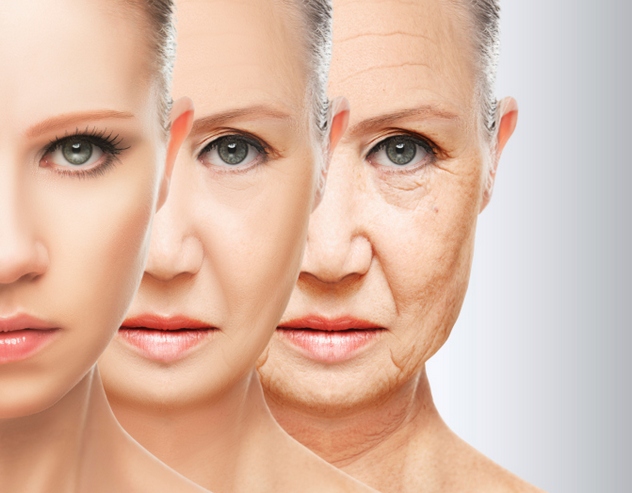(单词翻译:单击)
5.We're Not Really Sure What Colors Are
5.我们不能确定颜色?
Our world is filled with color, and for the most part, we've reached a consensus on what certain colors are. It's easy enough to identify a banana as yellow and broccoli as green, but what's to say one person's image of green is the same as another's? Not much, and it turns out that science really isn't sure that we're all seeing the same colors in the same way. The idea seems odd, especially considering that the mechanism that allows us to see colors is essentially the same: Light enters our eyes, it's interpreted there, and then it's processed by our brain. But it turns out that it's not as clear-cut as that, and the idea of colorblindness is only part of the reason.
我们的世界充满了色彩,在大多数情况下,关于色彩的辨识,我们已经达到了共识。人们很容易识别出香蕉是黄色的以及花椰菜是绿色的,但一个人所形容的绿色和另一个人形容的能保证一样吗?事实证明,真的不能保证我们都看到的是相同的颜色。这个想法似乎很奇怪,但是考虑到一个事实,假设我们看到颜色本质上是一样的:光线进入我们的眼睛,但是由大脑处理过之后,大脑对颜色的理解就不一定一致了。事实证明,这种现象的发生,有部分原因是由于色盲的存在。

We know that different people have different numbers of photo receptors in their eyes. People who are colorblind have weak receptors, most commonly suffering from a deficiency in the ability to detect green (or variations of green). But there's another end to the spectrum, too: people who are theoretically incredibly sensitive to color. Tetrachromats can see more colors than exist in the normal color spectrum. To them, the rest of us appear colorblind.But that's a pretty extreme example, and experiments suggest that the way we see colors can differ considerably between individuals. When monkeys whose photoreceptors would normally only allow them to see blue and yellow were infected with a virus that changed the type of color their eyes could interpret, they demonstrated the ability to see these new colors. They recognized that the colors were different, but we have no way of telling what their brains were interpreting the colors as. They were essentially seeing new colors that their eyes had never had the ability to process, making the link between the eyes receiving colors and the brain processing colors even more vague.
我们知道,不同的人的眼睛会接收到不同数量的光。色盲的眼睛是已经疲软的颜色受体,缺乏检测绿色(或变化的绿色)的能力。除了色盲还有另一种光谱终结者的存在:这类人从理论上来说对色彩是非常敏感的。四色视者(注:正常人有三种视锥细胞,四色视者有四种,所以可以看到比别人更多的颜色)可以看到比正常存在的颜色光谱还要更多的颜色。对他们来说,我们其余的人就是色盲。但这是一个非常极端的例子,实验表明,我们能够看到的颜色在个体之间差别很大。猴子通常只能看到蓝色和黄色,但是当它们的感光细胞感染了一种病毒时,这种病毒会改变它们对颜色的理解,让它们展示出看到新颜色的能力。它们认识到,颜色是不同的,但是我们没有办法告诉它们的大脑怎么去解释看到了什么颜色。它们看到了新的颜色,但是它们的眼睛无法处理这个变化过程,使得眼睛收到的颜色之间的联系和大脑处理出来的颜色更加模糊。
4.Is A Virus Alive?
4.病毒是活着的吗?

For the most part, everything falls into one of two categories: It's either alive, or it isn't. Ever since scientists have been aware of the existence of viruses, they've been unable to successfully determine which of these two very distinct groups viruses belong to. Originally, viruses were thought to be alive. The scientists that discovered viruses saw them as organisms that could spread and multiply, suggesting that they were very clearly alive. By the 1930s, however, researchers from the Rockefeller University were finally able to get a look into what was going on inside a virus. Since it didn't have any metabolic functions, they decided that it wasn't alive.
在大多数情况下,一切病毒都分两种:它要么活着,要么死去。自从科学家们意识到病毒的存在之后,他们无法成功地确定哪些病毒活着,哪些病毒已然死去。最初,病毒被认为是活着的。科学家们发现病毒之后视他们为生物,因为病毒可以传播和繁殖,这表明这些病毒是活着的。然而,到了1930年代,洛克菲勒大学的研究人员终于可以看到病毒的内部。由于病毒没有任何代谢功能,他们认为病毒不是活着的。
But it's far from clear, as further research by the same team discovered that a virus also exhibits one of the key components of life: reproduction. It not only makes more of itself but creates more proteins and internal chemical structures. Viruses have also been known to change over time, evolve, and carry on processes like repairing damage done to them. All this seems to indicate they're alive, unless nonliving organisms are also capable of evolution, which seems like a pretty odd thing to even suggest. Viruses are also unable to carry on these processes outside of a living host, leading some to suggest that they're functioning on something along the lines of life borrowed from another organism—but that doesn't make the answer any more clear.
但这种发现让人更加困惑,同一个研究团队进一步的研究发现,病毒有生命的迹象之一:繁殖。它不是创造更多的本身,而是创造了更多的蛋白质和内部化学结构。病毒也会随时间发生变化,演变,甚至可以修复伤害。这一切似乎表明他们活着,除非无生命的物种也能进化,这似乎是一个相当奇怪的说法。病毒无法脱离活体而存在,这从某种程度上表明病毒是从活体身上汲取某种物质来生存的,但是这个说法并没有太大的说服力。
3.Why Do We Age (And At Different Rates)?
3.为什么我们的身体年龄有增长快慢之分?

Every day we deal with the problems of aging, ever so gradually. We've been doing it for as long as we've been a species, but we have no idea what actually causes it. We know what happens to cells as they age: Muscles lose mass, tissues become more or less rigid, connective tissues stiffen, and new cells become less and less efficient at absorbing nutrients and removing waste. We just don't know why.
我们每天都在面对身体逐渐老化的问题,并且在研究如何解决。 我们每天都在衰老,但实际上我们不知道是什么原因导致这种衰老。我们知道随着年龄的增长会发生什么:肌肉失去质量,组织变得刚性,结缔组织变硬,新细胞有效地吸收营养,但是新细胞变得越来越少,我们不知道为什么会这样。
There are a couple of different theories on why cells age the way they do, including the idea that the aging process is a by-product of the body's waste materials, or that it's because of damage done by external factors like ultraviolet rays. It's also been suggested that we're simply genetically programmed to age, and how fast or how well we age has nothing to do with external factors.Even more bizarre is the question of why we age at different rates. Looking at the methylation patterns of cells gives an indication of how old they are, and all of our cells age at different rates. Female breast tissue, for example, shows patterns and changes that indicate it's about three years older than a person's calendar age. At the other end of the spectrum are heart cells, which age more slowly and can actually test as being several years younger than the body as a whole. Just why the body ages as it does—and why it ages at all—is nowhere near being completely understood.
有很多理论来解释为什么细胞会随着年龄的增长而出现一系列的问题,包括认为身体年龄增长是人体废料的副产品,或者由于外部因素(如紫外线)的伤害。还有人表示是由基因决定了人的年龄,身体年龄增长的快慢与外部因素无关。更奇怪的是为什么我们存在年龄增长速度不一致的问题。观察细胞的甲基化模式(注:甲基化是指,在甲基转移酶的作用下,甲基基团从供体转移到DNA的碱基上)表明这些细胞年龄有多大,并且所有的细胞在以不同的速度老化。一些身体结构的年龄与人们实际的年龄会存在差距,例如有些检测心脏细胞的时候会发现心脏细胞的年龄比人们实际的年龄年轻。
2.What Causes A Migraine?
2.是什么导致偏头痛?

Those who are prone to migraines know what it feels like to have one starting. It's a special kind of headache that goes way beyond just pain and can include nausea, vomiting, painful sensitivity to stimuli, blurred vision, and even loss of consciousness. What we're not sure about is why some people get migraines and why there are so many different triggers for them. Some people can have migraines that are triggered by anything from a change in the weather to bright sunlight and physical exertion. For some, it's sensory—migraine can be triggered by a certain smell or exposure to a certain food, drink, or food additive.
那些容易偏头痛的人们好像都有种预兆。 这是一种特殊的病症,表现出来的不仅仅是头痛,伴随的症状还包括恶心、呕吐、视力模糊,甚至丧失意识。我们不确定的是为什么有些人会患偏头痛,为什么有这么多不同的触发因素。有些人的偏头痛可能是由于天气的变化和体力消耗引发的。有些人的偏头痛可能是接触某些气味或某种食物,饮料,或者食品添加剂而引发的。
Even those sensitive to certain triggers don't always get migraines when they're exposed to those triggers, and they can also come down with a migraine without being exposed. Just why it happens to people isn't known, although it's suspected that there's a genetic connection, because migraines seems to run in families. One suggestion is that people susceptible to migraines have parts of their brains that are more sensitive to certain stimuli than others or that migraines happen in response to certain changes in brain chemistry. So far, though, there have been no concrete findings regarding just what causes migraines in some people and not others.
甚至那些敏感型的总是会因为接触到某种触发物质而导致偏头痛。为什么人们会偏头痛呢,答案不得而知,有些人还怀疑偏头痛跟血缘有关系,因为偏头痛似乎在家庭中会传递。目前有一种说法是,容易偏头痛的人们的大脑有一部分对某些刺激非常敏感。不过,到目前为止,还没有具体的结论能够解释为什么有些人患偏头痛而有些人没有偏头痛。
1.Why Do Allergies Come And Go?
1.为什么过敏总是忽来忽去?

Living with allergies can be a nightmare. From not being able to indulge in ice cream or not being able to own a pet to feeling like you're always on the verge of coming down with the flu, allergies can make life difficult. Many people suffer from allergies, which makes it even more surprising that we have no idea why they have a tendency to come and go, seemingly at random. Almost any kind of allergy can disappear—and reappear—over time. Some people may find their symptoms are occasionally greatly reduced, even if they don't go away completely.
过敏体质的人们的生活更像是一场噩梦。很多人由于自己的过敏体质而无法吃冰淇淋或无法接触宠物,这种感觉会让你觉得生活极其不便。许多人患有过敏,但是有时候人们发现过敏总是忽来忽去,看似随意。几乎任何类型的过敏都有可能在一段时间内消失然后出现,循环往复。有些人可能会发现他们的过敏程度有时候会大大降低,即使症状不完全消失。
Peanut allergies are among the most potentially dangerous types of allergies, and it's recently been discovered that about 20 percent of people who have peanut allergies as children lose their sensitivity as they get older. As much as 80 percent of children with milk allergies outgrow their sensitivity by the time they're in their teens, and those allergic to eggs will also commonly outgrow the allergy. Blood tests can tell if an allergy is going away, and sometimes desensitization done with small amounts of food or food prepared in a certain way can help—but this should always be done under the supervision of a doctor. Even stranger is the fact that kids today are much more likely to outgrow their allergies than the kids of the last generation, which raises more questions than it answers.
花生过敏是最具有潜在危险的过敏类型,最近发现,大约20%的对花生过敏的孩子随着年龄的增长会失去花生敏感性。多达80%的小孩子对牛奶过敏,但是到青少年的时候就没有那么多了,那些对鸡蛋过敏的孩子也是如此。 通过血液测试可以告诉我们过敏是否消失了,并且有时候食用一些少量的脱敏食物能够对消除过敏有所帮助,但这应该在医生的监督下完成。更奇怪的是,孩子们会一代比一代更容易过敏,这个也引起了人们的思考,思考如何来消除过敏。
翻译:哈利小王子 来源:前十网


